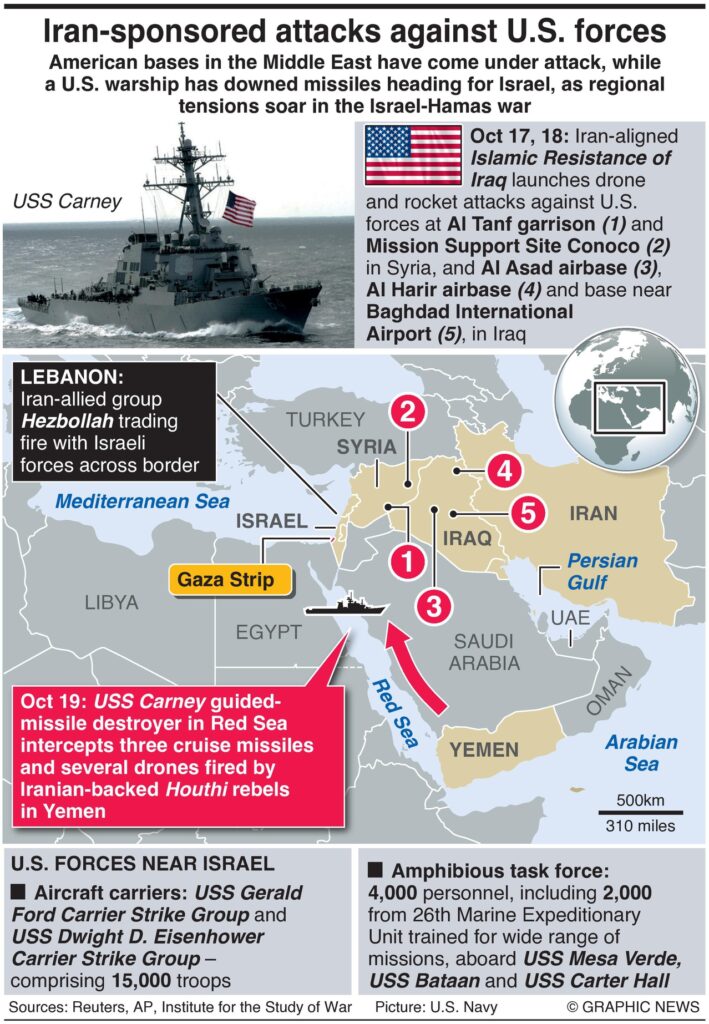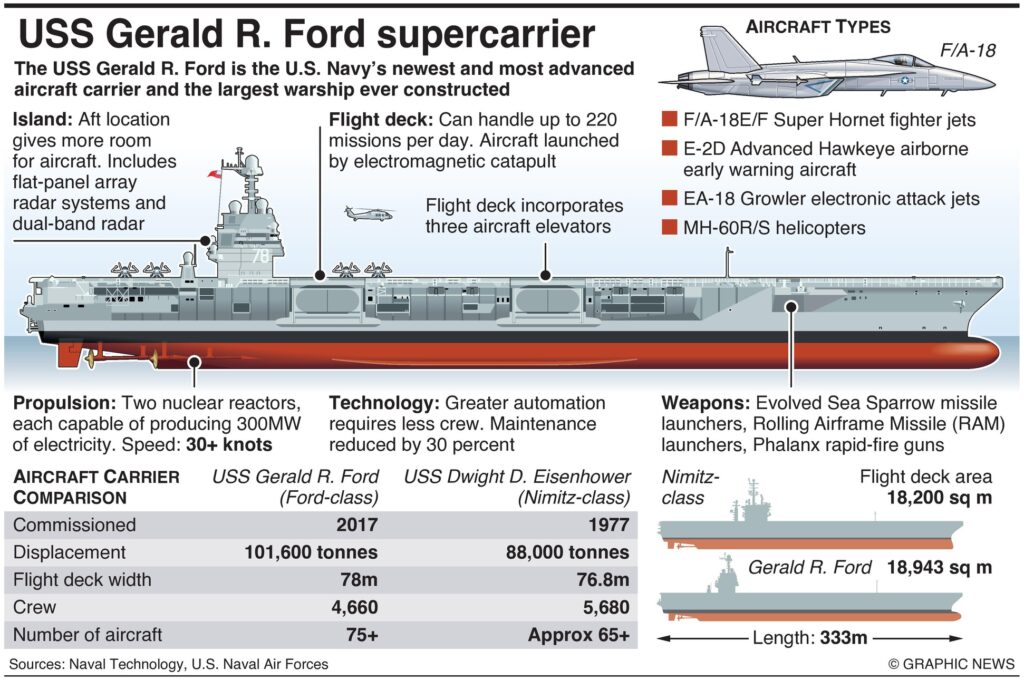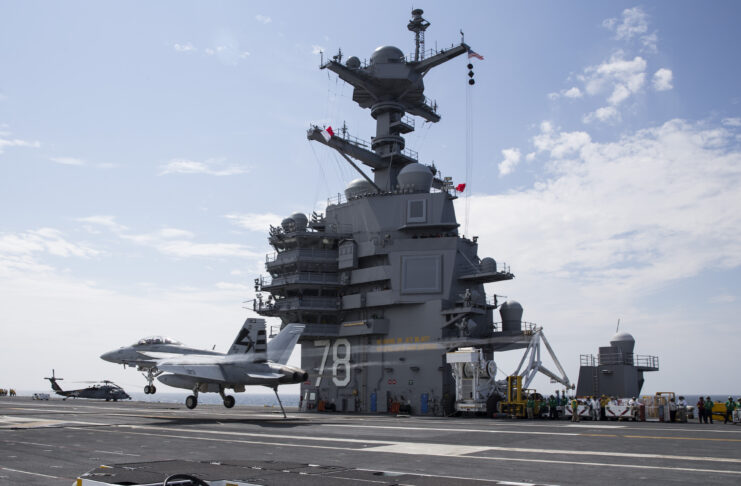ANALYSIS – While I can fault Joe Biden for helping create the current Israel-Hamas-Iran crisis by his yearlong kowtowing and funding of Tehran and his recent weak symbolic strikes against Iran-backed terrorists, his forward deployment of two carrier strike groups and Marines to ‘deter' Iran is praiseworthy.
Whether the Iranians or their terror proxies have any fear that Biden will use them fully is the big question. (RELATED: Biden Tit-For-Tat Response To Iranian-Backed Militia Attacks On US Troops)
But for now, these naval forces, in addition to additional U.S. Air Force fighters and attack aircraft, various missile defense systems and other troops in the region, will help provide our staunch Middle East ally with a significant and powerful naval bubble from both the eastern Mediterranean and the Persian Gulf/Red Sea/Indian Ocean areas.
At the center of this protective bubble are two aircraft carrier strike groups centered on the USS Eisenhower and the USS Ford supercarriers.
The U.S. also has a Marine Expeditionary Unit (MEU) task force or Amphibious Ready Group (ARG) centered around the helicopter assault ship USS Bataan (LHD-5).
This adds the equivalent of a small carrier, with helicopters and F-35B aircraft, as well as 2,000 Marines, to the mix. (RELATED: Biden, US CENTCOM General, Marines And F-15s Head To Israel)

As Le Monde reported:
Three weeks after the start of the war between Israel and Hamas, US naval deployment in the Mediterranean is reaching levels rarely seen before. With more than 15 surface vessels and over 15,000 soldiers, not counting the escort submarines, the American response goes beyond mere reassurance to reflect real concerns about the risk of regional escalation, particularly with Iran.
A milestone will be reached when the second aircraft carrier announced by the Pentagon on October 14 passes through the Strait of Gibraltar. Currently, the USS Dwight D. Eisenhower, which sailed from Norfolk, Virginia, on the East Coast of the United States, is still in the middle of the Atlantic. It was originally intended to take over from the USS Gerald R. Ford, the first aircraft carrier already in the Mediterranean, which was diverted to Cyprus on October 9, the day after the Hamas attacks. But as the USS Gerald R. Ford is the largest and newest of the US Navy's 11 aircraft carriers, the Pentagon chose to keep it at sea.
According to military experts, however, the two carriers are not expected to remain together in the Mediterranean. US Secretary of Defense Lloyd Austin hinted at this on October 14. Xavier Vavasseur, editor-in-chief of Naval News, noted, “The USS Gerald R. Ford will remain under United States European Command, while the USS Eisenhower has been placed directly under United States Central Command, the hub responsible for military operations in the Middle East. It could therefore make its way toward the Red Sea and the Persian Gulf.”
…
The US aims to form a very large naval bubble around Israel, containing the risk of retaliation from Iran or armed groups affiliated with it, from Hezbollah in Lebanon to the Houthis in Yemen. These groups are equipped with sophisticated weaponry containing a whole range of missiles capable of reaching distances of up to 2,400 kilometers, and therefore potentially capable of reaching Israel. Hezbollah's arsenal, in particular, is estimated at over 120,000 missiles and rockets, including guided munitions. These could penetrate the Iron Dome, Israel's air defense system…

As I wrote about earlier, these US naval forces have already proven their worth – and validated one of their missions – by last week downing numerous drones and missiles launched by Iran-backed Houthi militants in Yemen toward targets in Israel. (RELATED: ‘Shot To Pieces': Tucker's Guest Makes Uncorroborated Claim About US Forces Entering Gaza)
In another piece I explained:
In what was potentially a U.S. Navy first, on Thursday, ABC News reported that: “The USS Carney, a U.S. Navy guided-missile destroyer in the northern Red Sea, on Thursday shot down multiple missiles and drones launched by Iranian-backed Houthis in Yemen that the Pentagon said were potentially headed toward targets in Israel.”
The Carney is part of the USS Gerald R. Ford carrier strike group deployed in the eastern Mediterranean. The Houthi missiles and drones were intercepted by the ship's SM2 air defense missiles.
As ABC News noted, “The USS Carney had just transited into the Red Sea through the Suez Canal on Wednesday, which is why the destroyer was still located in the northern stretch of that body of water that borders Egypt's Sinai Peninsula, Sudan, Saudi Arabia, and Yemen.”
The Pentagon said that the Carney had brought down eight drones launched by the Houthis and that they did not appear to be threatening the U.S. warship. This would be a first.

This event shows the powerful air defense capabilities that U.S. naval forces nearby can employ. But the offensive capabilities of U.S. carriers are what makes these strike groups truly and rightfully feared.
Hopefully, we won't need to see more ‘firsts' by U.S. forces in the region, but they are there if the current commander-in-chief has the will to use them.
The opinions expressed in this article are those of the author and do not necessarily reflect the positions of American Liberty News.
READ NEXT: Poll Shows Biden's Numbers Dropping Precipitously – Within His Own Party


